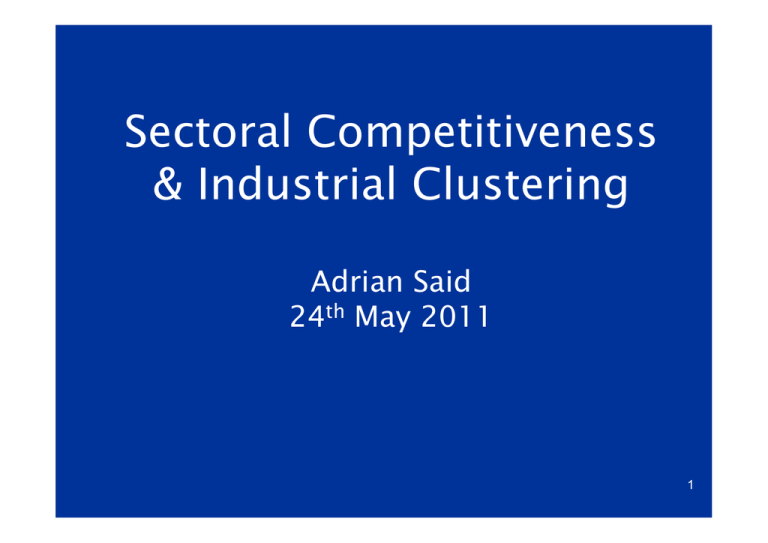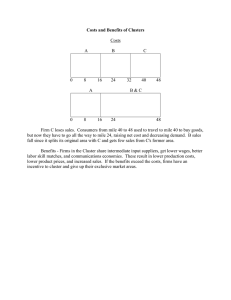Sectoral Competitiveness & Industrial Clustering Adrian Said 24
advertisement

Sectoral Competitiveness & Industrial Clustering Adrian Said 24th May 2011 1 What is National Competitiveness? Raising productivity— meaning making better use of available factors and resources— is the driving force behind the rates of return on investment which, in turn, determine the aggregate growth rates of an economy Thus a more competitive economy will be one which will likely grow faster in a medium to long-term perspective The Global Competitiveness Index It is important to note that none of these factors alone can ensure competitiveness Example: The value of increased spending in education will be undermined if rigidities in the labor market and other institutional weaknesses make it difficult for new graduates to gain access to suitable employment opportunities Global Competitiveness Index 1) Top 3: Switzerland, USA, Denmark 3) EU Countries dominate Top 20 Despite the financial crises the US still tops the list due to a number of competitive strengths Switzerland ranks - 1 Competitiveness = Productivity Why Clustering? “Clustering” is the tendency of vertically and/ or horizontally integrated firms in related lines of business to concentrate geographically to maximise productivity What are industrial clusters? Industrial clusters are regional or urban concentrations of firms including manufacturers, suppliers and service providers, in one or more industrial sectors These firms are supported by an infrastructure made up of universities, research institutes, financing institutions, incubators, business services and advanced telecommunications systems. The concept of industrial clustering fits the notion of systems of innovation since both deal with capabilities and relationships What are the advantages of Clusters? Increase of employment Spread of innovation Upgrading of skills Upgrading of quality of products Increase of productivity of companies involved in clusters Increase of export volume Efficient use of resources (R&D, marketing, access to finance) Cluster Characteristics Strong linkages among firms and the supporting technological and business infrastructure in a region stimulate the innovation process and the growth of the cluster; Geographic proximity of firms, educational and research institutions, financial and other business institutions enhances the effectiveness of the innovation process; The larger the cluster (e.g. large number of firms and workers) the higher the level of self-sufficiency; i.e. less need to get key functions (e.g. supplies, financing) supplied from outside; that is there is less “leakage” outside the cluster. Examples - 4 motors of Europe Lombardy Lombardy, whose capital city is Milan, is the economic engine of Italy. This state, with its population of 9 million, is responsible for about 21% of Italy’s GDP. Its per capita income is 30% above the Italian average. Lombardy is a major trading centre and accounts for some 30% of Italy’s exports. The region accounts for one-third of the active corporations in Italy. While there are many large conglomerates, such as Montedison, most of the 200,000 industrial firms, which represent about 45% of industrial employment in Italy, are small and medium-sized enterprises (SMEs). It has major concentrations in the telecommunications informatics and chemical sectors as well in services such as engineering consulting. Lombardy accounts for 32% of Italy’s government R&D and 40% of its private sector R&D expenditures. Milan itself has four universities, one of which, the Polytechnico is said to be the MIT of Italy. Lombardy is more R&D intensive than any other region in Italy. Examples - 4 motors of Europe Baden-Wuerttemberg The capital is Stuttgart, has a population of 9.4 million and produces about 17% of Germany’s exports. Many of these exports are “high-end” automotive products since Mercedes-Benz, Porsche and Bosch are located in this state. Zeiss also adds to the high value-added exports of the state. Overall, there are some 12,000 manufacturing firms in the state, 95% of which are SMEs. Baden-Wuerttemberg accounts for about one-quarter of Germany’s automotive and electronics/electrical production. Given its industrial mix, Baden-Wuerttemberg has highly developed expertise in electronics and electrical goods, machinery, automotive engineering and precision engineering. The state has the highest concentration of research institutes in Europe and accounts for 30% of Germany’s R&D capability. There are nine universities, 23 polytechnics, 11 Max Planck Institutes and 14 Fraunhofer institutes and research centres. Examples - 4 motors of Europe Baden-Wuerttemberg A key element of Baden-Wuerttemberg’s technical infrastructure is the Steinbeis Foundation for Economic Promotion, a not-for-profit corporation, whose mandate is to support the development of industry in the state, especially SMEs, through the provision of R&D, technical advice and financial support. The Foundation, has 114 technology centres spread throughout the state. More than 70% of its revenue comes from consulting and R&D services. The Chairman of Board is also the Baden-Wuerttemberg Government Commissioner for Technology Transfer which gives an indication of the importance that the state attaches to technology development. Examples - 4 motors of Europe Catalonia The capital is Barcelona, is Spain’s industrial centre. It has a population of 6 million and generates nearly 20% of Spain’s GDP and accounts for 27% of Spain’s industrial output. Some 40% of its industrial activity is in manufacturing. Catalonia attracts industry because it can offer a skilled labour force at relatively lower wage rates than the rest industrialized Europe. In 1987, the Valles Technological Park (PTV) was established to encourage the development high-technology development. The PTV is co-located with the National Microelectronics Centre and the University of Barcelona. The five areas of interest of the PTV are microelectronics, telecommunications, advanced automation, biotechnology and new materials. Catalonia sees itself in a catch-up situation vis-à-vis the other Motors and has an aggressive policy to attract foreign investment. For example, it receives about 70% of all Japanese investment in Spain involving firms such as Sony, Nissan, Toshiba and Sanyo. Clusters as tools for local and regional economic development • Established wisdom: Private sector must lead cluster development initiatives with public sector playing catalytic role • Reality in transition economies: Private sector is composed of atomised actors lacking financial and social resources Government may have to jumpstart the process and provide financial and organisational support to firms • Solution: Cluster support policies with shared responsibilities among actors Why New Approach to Economic Development Key messages: Be more strategic / be a more intelligent player Old ways of analyzing the economy are not enough anymore Location still matters—but for different reasons Traditional economic development programs are increasingly criticized for... not focusing on key goals (increasing the competitiveness of business), targeting individual firms, not thinking strategically, not reaching enough firms to make a difference, presenting a fragmented and confusing maze of programs and services, not being industry driven, and not being accountable to private sector clients or public sectors funders. Place Still Matters — But for Different Reasons “The enduring competitive advantages in a global economy lie increasingly in local things—knowledge, relationships, motivation—that distant rivals cannot match.” “This role of location has been long overlooked, despite striking evidence that innovation and competitive success in so many fields are geographically concentrated.” Michael Porter - Industry Clusters as an Analytical Tool Identifying Industry Clusters Business Interdependence: Arizona chose clusters where businesses relate to each other through the buyer-supplier “food chain,” as competitors, or as partners. Export Oriented: Many of the companies in the cluster sell products or services to companies outside the region. Concentration: Employment in the cluster is more concentrated in the region than the national average, and the cluster is an existing or emerging area of specialization. Significant Size or Rapid Growth: The cluster is of a significant size or, if new, has an above average growth rate compared to that of the U.S. as a whole. Industry Clusters as an Organizational Tool Charge to Each Cluster Catalogue the key components of the cluster Articulate an achievable vision of what the cluster can become over the next 10-20 years Identify opportunities for growing the cluster in the desired direction by expanding existing companies and attracting outside companies Identify opportunities for more synergy within the cluster Identify needs for specific economic foundations and proposed strategies Power of Collaboration: Optics Cluster Example Identify critical mass optical components; optical design software; lasers for medical, industrial and graphics application; optical telescopes; digital electronic camera formed association state and local recognition: “seat at the table” national recognition—Business Week: “Optics Valley” 4-year program to build exports joint ventures among optics firms joint ventures with other clusters workforce development: community colleges, school-towork grant Industry Clusters as a Service Delivery Tool Benefits of Cluster Approach to Economic Development First time to mix entrepreneurs and traditional business (banks, utilities) CEOs in process to develop an economic development strategy Cluster-based approach provided a more in-depth understanding of the state economy Produced an industry-driven strategy Recognized that industry does not speak with a single voice Created a broader constituency for economic development Changed the way we define the customer Conclusion: Why Clusters are Important to Regions Clusters generate wealth, exports, jobs, sources of information Firms are attracted to clusters because of: economies of scale productivity advantages marketing and other competitive advantages Globally, clusters are driving regional growth Conclusion: Clusters offer special opportunities to better provide assistance by: reaching and educating all competitive companies in a sector accelerating the learning curve and confidence with opportunities for firms to learn from firms offering a format for delivering wellcoordinated services Conclusion: Distinguishing Characteristics Technology is a given Globalism is here to stay Knowledge builds wealth People are the most important raw material There’s no such thing as a smooth ride Competition is relentless Alliances are the way to get things done Place still matters—but for different reasons Conclusion: Firms Cluster in One Place for Bottom Line Reasons Reduce transaction costs Specialize Exploit one another’s specialties Increase rates of innovation Pursue joint solutions to common problems Build a common labor pool, technology, infrastructure: Learn collectively what it takes to be competitive Place Still Matters — But for Different Reasons “The enduring competitive advantages in a global economy are often heavily local, arising from concentrations of highly specialized skills and knowledge, institutions, rivals, related businesses, and sophisticated customers.” - Michael Porter Harvard Business School Anything that is available to rivals elsewhere is essentially nullified as a source of competitive advantage.



